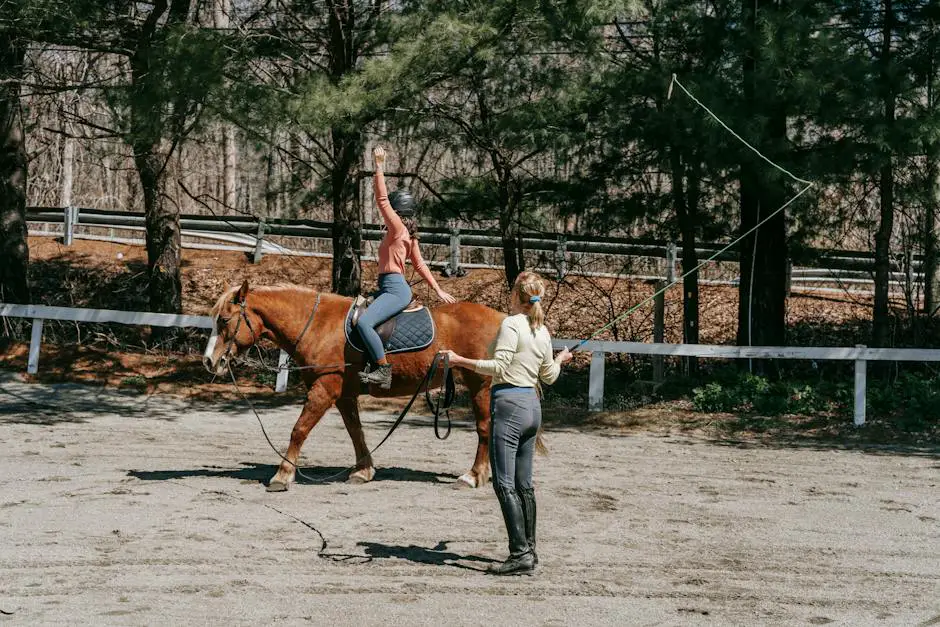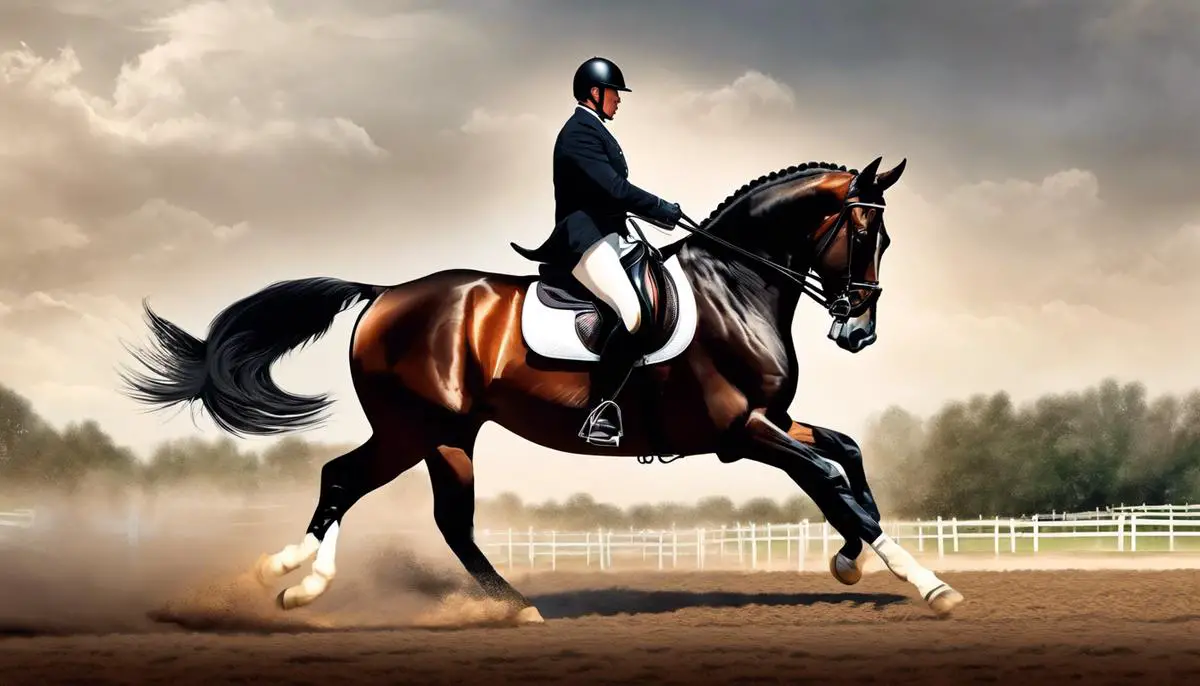In the fascinating world of equestrian sports, Warmblood horses are renowned for their noble stature, remarkable athleticism, and enduring spirit. These distinguished breeds, which combine strength of draft horses and speed of hot-blooded horses, have not just shaped our past, but continue to shape contemporary equestrian activities such as dressage, eventing, and show-jumping. Nevertheless, those mesmerizing characteristics are just the tip of the iceberg when delving into the intricate sphere of Warmblood life dynamics. Taking a broader perspective, three key aspects that shape their lifespan are health, genetics, and lifestyle. Lifestyle encompasses both their living environment and the effects of human involvement
Table of Contents (Horspedia)
Warmblood Horse Basics
There’s an unparalleled charm about Warmblood horses that makes them an elite breed, standing out among their equestrian counterparts. Their regal stature, superior athleticism, and compassionate temperament declare them a class of their own. But, what are those exclusive factors that render the Warmblood its prestigious reputation?
Well, to begin with, Warmbloods are synonymous with versatility. While most horse breeds are known for a specific task, these noble creatures exhibit remarkable efficiency in various disciplines. Be it dressage, show jumping, eventing or even vaulting, Warmbloods have consistently stolen the show, stamping their undeniable authority and adaptability. Crediting their majestic size and power, these horses embody sheer excellence by translating their robust physical strength into spectacular performances.
Warmbloods are not about strength and athleticism alone but also prominently showcase a well-balanced temperament. Born with a calmer demeanor, they possess an exceptionally docile and cooperative nature compared to their hot-blooded counterparts. This characteristic particularly makes them an ideal choice for amateur riders and professionals alike. When patience, willingness to learn, and quiet sensibility are sought, Warmbloods naturally step into the limelight.
Warmbloods, no doubt, command attention with their physical traits as well – they are a breed of great presence and elegance. A typical Warmblood stands between 15.2 to 17.2 hands tall, signifying their grandeur. Their athletic body connotes strong functionality with a deep chest, strong back, and sturdy legs. What really sets them apart is their gleaming eye—the mark of intelligence—and arched neck, exuding an air of pride and grace.
Understandably, selective breeding also plays a significant role in setting Warmblood horses apart. Historically, these horses were bred strategically to promote certain desirable attributes. War horses turned farmers’ horses turned sports horses, the Warmbloods are a testimony to the wonders of purposeful breeding. Precise genetic codes have been passed down generations to give birth to this breed that beautifully marries strength with serenity.
The enchanting world of Warmbloods is more than just horses—it’s an emblem of grace, power, and resilient spirit. Standing tall as versatile performers, ultra-temperate companions, and living epitomes of purpose-based breeding, they are indeed the crowning glory of the equine kingdom. As you plunge deeper into the realm of these noble creatures, every narrative, every stride, every achievement will confirm why Warmbloods truly set a benchmark for their peers.

Warmblood Horse Health Factors
Overseeing the Lifespan and Vigor of Warmblood Horses: Crucial Factors to Consider
Far beyond their commendable versatility and balanced temperament, Warmblood horses inject an undeniably magnetic charm to the equestrian world. These equine marvels stand as a testimony to strategic selective breeding, which has harmonized physical prowess and temperament into an ideal horse breed. Yet, as fascinating as their origin and genetic make-up is, it’s equally vital to delve into the factors that significantly shape their health and lifespan.
Foremost, let’s put the spotlight on Nutrition. The old adage, you are what you eat, rings especially true for Warmblood horses. A balanced diet replete with essential nutrients – proteins, vitamins, and minerals, holds the key to their superior health. Feeding practices should follow the horse’s age, weight, and activity level. An ill-balanced meal plan can lead to nutritional deficits or excesses, impacting the horse’s overall health and shortening their life expectancy.
Secondly, the significance of Regular Exercise cannot be overstated. Keeping a Warmblood in good form requires a consistent exercise routine. This breed is prone to developing potentially life-threatening conditions like tendonitis, colic, and laminitis if left sedentary for too long. A fit and active Warmblood horse can reach and often surpass the breed’s average lifespan of 20 years.
Another paramount aspect is Routine Veterinary Care. Regular vet checks help diagnose, prevent and manage potential health issues. Even the most meticulously cared-for Warmblood is susceptible to diseases, parasites, and injuries. Regular deworming, vaccinations, and dental checks are integral to a horse’s health regime, ensuring that these majestic creatures live long, healthy lives.
Equally crucial is the Warmblood’s Living Conditions. Subpar housing conditions can lead to stress, accelerating health complications, and reducing lifespan. An ideal environment offers enough space for free movement, clean and dry stalls, as well as ample social interaction with other horses. A well-designed and managed habitat not only supports physical health but also nurtures their mental well-being.
Towards the same end, a horse’s mental health is not to be overlooked. Stress Management is key. Warmblood horses are known for their docile demeanor, yet they, too, can succumb to stress. Constant exposure to stressful conditions can lead to behavioral problems, poor performance, and chronic health issues, directly impacting their longevity. Providing a calm, stable environment, regular exercise, and socializing time with other horses are proven stress busters.
Lastly, Weight Management is a significant issue in Warmblood horses. Overweight horses are at an increased risk for serious health conditions such as insulin resistance, laminitis, and heart disease. Regular monitoring and proper diet with an appropriate exercise routine can prevent unnecessary weight gain, averting these health risks.
Warmbloods are not just a horse breed – they embody the harmonious blend of strength, grace, and cooperative spirit. Ensuring these horse’s health and longevity may seem a formidable task, but it’s an endeavor well worth undertaking. Through proper nutrition, management of their environmental conditions, care of their mental health, and strict adherence to vet checkups, these equine wonders can enjoy long, thriving lives, bringing immense delight to those privileged to share their company.

Genetics & Breeding Effect on Lifespan
The Remarkable Influence of Genetics and Selective Breeding on Warmblood Horses’ Lifespan
Peering into the fascinating world of Warmblood horses, it’s impossible not to marvel at how genetics and selective breeding have continually played essential roles in molding these horses’ values including notably, their lifespan.
When talking about lifespan, one can’t ignore that the genes inherited from a Warmblood’s sire and dam form the cornerstone of their longevity. The genetic makeup of Warmblood breeds like the Dutch Warmblood or the Hanoverian contains numerous complex traits that deeply influence life expectancy. These traits include, but aren’t limited to, disease resistance, adaptive metabolic rates, bodily agility, and robustness in enduring harsh conditions. Therefore, a horse’s genetic baseline does matter immensely in determining how long they might live.
Selective breeding, on the other hand, has evolved into a strategic art to foster the genetic variation that fuels adaptation and survival in the Warmblood species. Through the intricate process of selecting parent Warmbloods with desirable traits such as vitality and resilience, breeders have been successful in extending their average lifespan significantly.
One critical example of this is the breeding efforts that have focused on strengthening the Warmblood’s cardiovascular system. Horses with robust heart health are more likely to outlive those prone to cardiac diseases, and thus, breeders select mates based on heart size, ability to recover after exertion, and other echo-cardiogram results, resulting in longer-living progeny.
Selective breeding has also been leveraged to propagate Warmbloods with superior immune systems. Enhanced disease resistance becomes an asset, shielding them from the possible health threats that might curtail their life expectancy. By consciously choosing to breed horses with robust immune responses, breeders have actively increased the survival rate and lifespan of these splendid animals.
Moreover, the modern breeding programs also take into account the Warmblood’s skeletal structure. A horse with a sound and robust skeletal system significantly reduces the risk of debilitating injuries or musculoskeletal issues, further extending their lifespan.
Does this mean every Warmblood horse with a strong genetic lineage and born out of selective breeding will certainly have a long life? Not entirely! While these components indeed contribute majorly to a Warmblood’s lifespan, one must remember that they interplay with external factors too. Maintaining an optimum living environment, a balanced diet, adequate exercise, and regular health check-ups also add to the equation leading to an overall increase in the lifespan of a Warmblood horse.
In conclusion, genetics and selective breeding present breeders and horse enthusiasts with a potent tool to understand, influence, and improve the lifespan of Warmblood horses, giving us more years to enjoy their grace, strength, and companionship.

Lifestyle and Environment Effects on Lifespan
Delving into the world of Warmblood horses embraces unraveling the understanding of a lifestyle that affects their longevity. This delicate interplay between environment and lifestyle not only enhances their lifespan but also refurbishes their overall health and well-being.
Firstly, nutrition plays an integral role in enhacing a Warmblood’s lifespan. Providing a balanced diet rich in proteins, fats, vitamins, minerals, and carbs contributes significantly to their vitality. This is because much like humans, horses need a well-rounded diet for every stage of their life. Therefore, Warmblood owners must maintain a consistent feeding regimen, offering a blend of hay, forages, grains, fresh water, and supplements. Moreover, considering the high activity levels of Warmbloods, the food should meet their energy demands whilst avoiding obesity.
Next up, regular exercise! It’s enough to stress that an active lifestyle is no less than a magic potion for increased lifespan. Warmblood horses require both physical and mental stimulation to lead a healthy life. Besides, their agility and endurance level demands routine workouts. It can be anything from lunging, riding, training for dressage, or simply a several-mile walk.
Routine veterinary care is yet another key contributor to a fulfilling Warmblood lifespan. Regular vet examinations, dental checks, vaccinations, deworming, and hoof care are the equivalent of an annual health check-up in humans. This preventive care goes a long way in identifying and addressing any health concerns before they escalate, thereby improving the horse’s life expectancy.
Living conditions also greatly impact a Warmblood’s lifespan. Spacious stables, well-ventilated barns, and ample grazing land ensure good health and contentment – both are vital for a long-living horse. A secured fencing setup is also essential to eliminate risks of injuries. Interaction with other horses, access to shelter during adverse weather, and maintenance of cleanliness levels would further enhance their life expectancy.
Another lifestyle parameter is stress management. Any abrupt changes in the routine or environment can cause stress; hence a familiar and stable routine is encouraged. Avoiding overcrowded spaces, excessive noise pollution, and providing gentle companionship can significantly help prevent unnecessary stress.
Last but not least, weight management is crucial in determining a Warmblood’s lifespan. Obesity may lead to a myriad of health issues, such as equine metabolic syndrome, laminitis, and Cushing’s disease. Regular weight checks, coupled with a balanced diet and exercise, are therefore essential to maintain an ideal weight.
Moreover, genetics and selective breeding play a substantial role in a Warmblood’s lifespan. The robust genetic makeup and selective breeding practices have gifted these horses with impressive resistances to diseases, a strong cardiovascular system, and a hearty skeletal structure. There’s an incredible depth to the complexity and insights offered by their genetics and selective breeding.
Warmblood horses are the epitome of resilience, agility, and robustness, due to a competent blend of genetic factors and lifestyle choices. Every stride they take in their well-manages environment directly affects their lifespan, paving the way for a phenomenal life journey. There’s a realm of practices, knowledge, and skills to adhere to when it comes to Warmbloods, unlike any other breed, that makes nurturing them nothing short of intriguing.

So, having a holistic understanding of Warmblood horses, probing into their basic traits, health prerequisites, genetic make-up, and their lifestyle conditions gives us a comprehensive view of the factors that influence their lifespan. The majestic Warmblood horse is a true embodiment of resilience, power, and delicate grace, captivating the hearts of equestrians worldwide. By pledging our commitment to ensuring optimal health, advocating for mindful breeding practices, and promoting a fulfilling living environment, we can hope to extend the lifespan of these magnificent animals, and in doing so, continue our shared journey into the future of equestrian pursuits and horse-human relationships.
